2011 Sea-Doo GTX 155 Review
High-tech features, high-end hull and deck combine in appealing mid-level craft
Sea-Doo tends to get a lot of attention for the company’s highest and lowest end models, but the midrange has quietly improved. Certainly the venerable GTX 155 has long benefited from the hand-me down effect, but last year those gifts reached an all-time high. Changes in both the hull and deck, as well as some high-tech control features, made their debut on the craft.
For 2011, the boat returns strongly positioned to take advantage of all those features…and make consumers think twice about where to spend their money.
In Control
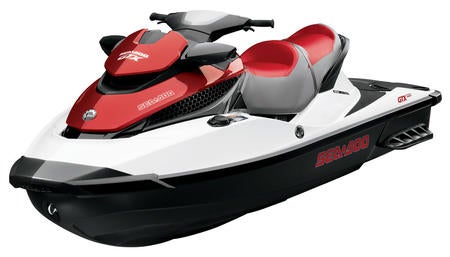 The GTX 155 benefits greatly from Sea-Doo’s iControl technology.
The GTX 155 benefits greatly from Sea-Doo’s iControl technology.iControl technology made its debut on the GTX 155 in 2010, and continues to give the boat enhanced control in 2011. Intelligent Brake and Reverse (iBR) allows the craft to start in a “neutral” mode, then be shifted into forward or reverse with a grip of the appropriate handlebar control — throttle or the reverse/brake lever. That immediately gives the boat a more confident feel at the dock or launch ramp. Underway, that same portside lever can be used to brake the craft’s forward motion. The computer shuts off thrust, drops the reverse bucket, then reapplies a controlled amount of power in literally an instant. That redirected water flow slows the craft in nearly half the distance of a non-brake version. By feathering the brake pressure, you can control the force of the stop. Handlebar controls also mean eyes stay focused on the water.
It’s a good feature, especially for beginners. With time, an experienced rider will learn to use the throttle to get out of certain stopping situations, or develop a feel for the craft’s electronic off-throttle steering, but braking has changed the way you can ride, and overall I think it’s for the better.
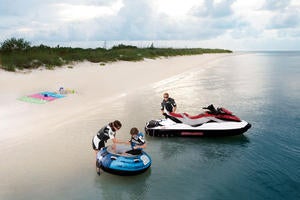 Features like electronic throttle and cruise control make towing duties much easier.
Features like electronic throttle and cruise control make towing duties much easier.The other iControl feature of note is electronic throttle. By eliminating the physical cable between throttle and engine, the throttle not only takes on a different feel, but Sea-Doo is also able to offer features like cruise control, which is quite handy for an extended ride or when towing a skier or wakeboarder, as well as a no-wake mode that allows the driver to release the throttle and hold a minimum speed in extended slow-speed zones. Settings can be changed in small increments with a tap of up/down arrows.
Electronic throttle also splits the boat’s personality by offering two different acceleration profiles, the default touring for those that want a slightly tamed ride, and the optional sport mode when you want the engine’s full potential on tap. A minor annoyance is that sport-minded riders will have to opt out of the default touring mode every time they start the craft.
Hull-abaloo
Sea-Doo gave the GTX 155 a new hull design in 2010, a design that gives the boat a far more confident ride in rough conditions, yet still can carve a flat glass lake like a surgeon. It’s a bigger boat (nine inches longer than the last GTX hull), with a commanding presence the family will appreciate, especially on larger bodies of water. A lighter weight material has been used, and internal ribbing gives the hull better strength. A speedboat-inspired step reduces drag to create better top speed.
The design, borrowed from Sea-Doo’s original suspension models but without the floating rider pod, is both aggressive and attractive, but has one shortcoming. The makeover reduces stowage. A capacity of 14 gallons is certainly enough for the basics, but cavernous bow tubs are found on some competitive models. Sea-Doo’s lift-out tub is handy to carry stuff from house or car to boat and vice versa, but it adds a step when you’re trying to quickly access it while underway.
Engine access, however, has no such shortcomings. A trick, single-piece seat rises on a gas strut, eliminating the worry of where to wrestle the saddle.
Other nice features include electronic trim, tilt steering, a nice display with fuel-consumption stats, a supportive, touring-style bolstered seat, and a convenient flip-down boarding step.
As to power, it comes from the non-supercharged version of the same 1,494cc Rotax engine that, in various forms, powers the entire line. In its simpler form here, it produces 155 hp, which in today’s market is mid-level at best. Still, the engine provides enough pulling power to tow that skier or wakeboarder or tube, and moves the craft to a top speed in the neighborhood of 57 mph. That’s a good usable range for this audience, and the engine won’t suck down fuel at nearly the rate of its supercharged siblings. It also allows you to use 87 octane, which with today’s prices, means more fuel to burn over the course of a season.
Conclusion
While the older GTX hull still has its fans, I’ve grown to like the new hull much better. It carves equally as hard as the previous model, but is far superior in rough water. And let’s face it, that’s a reality more often than not in many places. Add in the impressive braking and electronic throttle control features, and I think Sea-Doo has a lot to offer in this midrange category.
You owe it to yourself…and your wallet…to give this middle child a chance.
| Sea-Doo GTX 155 Specs | |
| Length | 139 inches |
| Beam | 48 inches |
| Curb Weight | 825 lbs |
| Engine | Naturally aspirated three-cylinder |
| Displacement | 1,494 cc |
| Bore and Stroke | 100 mm x 63.4 mm |
| Compression Ratio | 10.6:1 |
| Rated Horsepower | 155 |
| Fuel Capacity | 15.9 gal. |
| Combined Stowage Capacity | 13.7 gal. |
| Colors | Autumn Red |
| Price | $11,799 |
Related Reading
2011 Sea-Doo GTX Limited iS 260 Review
2011 Sea-Doo GTI Limited 155 Review
2011 Sea-Doo GTI 130 Review
2010 Sea-Doo GTX 155 Review
Get PersonalWatercraft.com in your Inbox!
Like PersonalWatercraft.com on Facebook
Comments
Most Popular

2025 Yamaha JetBlaster PRO 2-Up Review

Remembering the Sea-Doo XP

2024 Kawasaki Jet Ski STX 160X Review

2017 Kawasaki Jet Ski Ultra 310LX Review

Whatever Happened to the Wetbike?




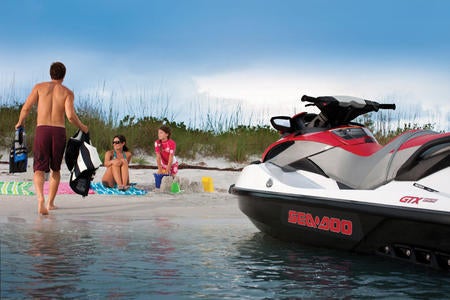
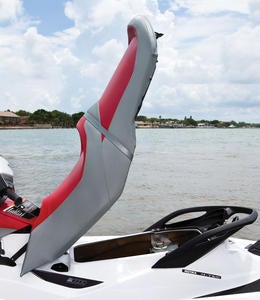
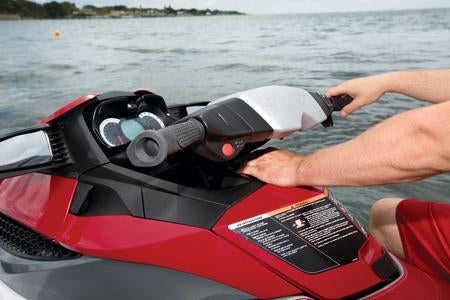







 Your Privacy Choices
Your Privacy Choices